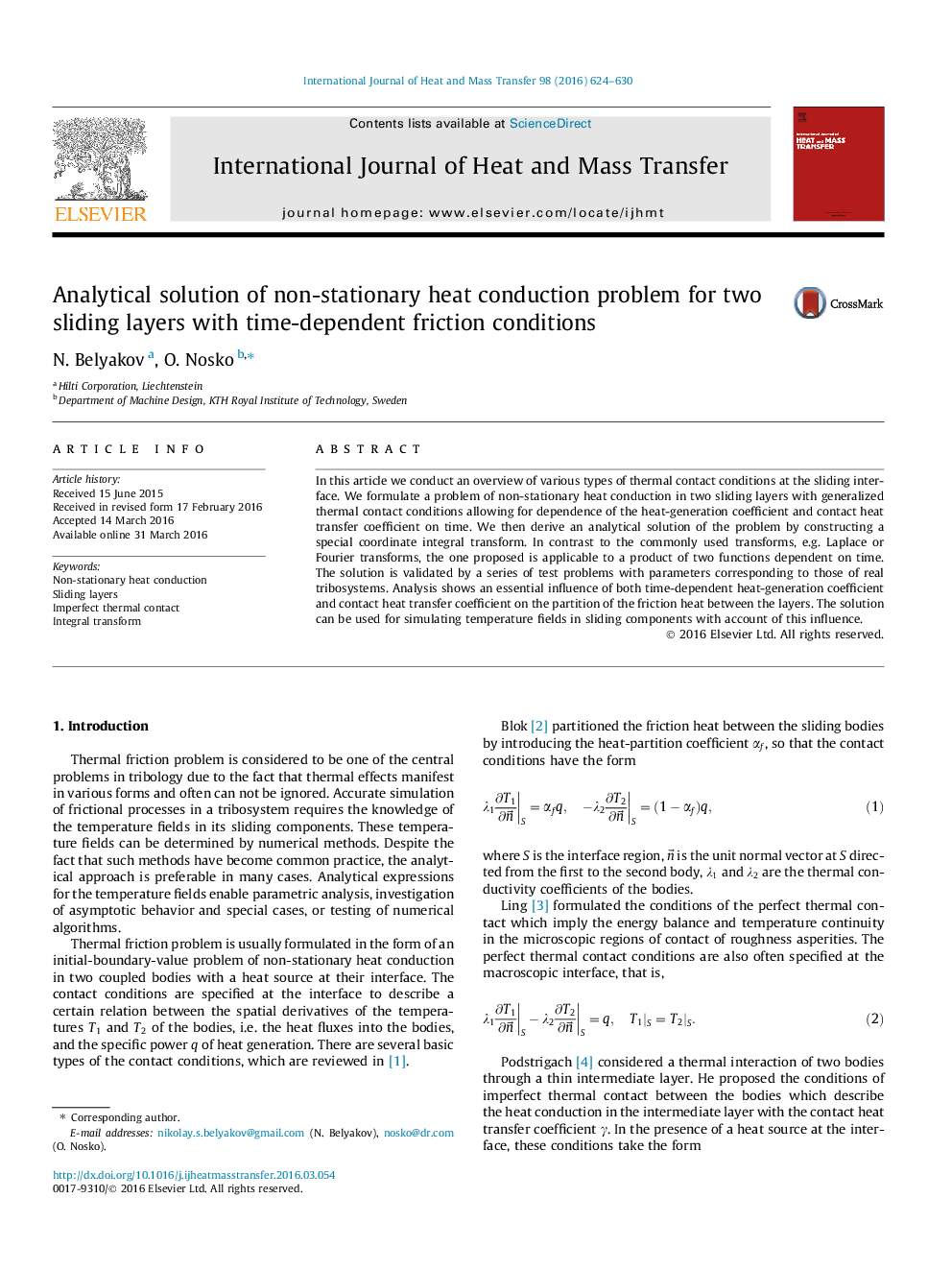| کد مقاله | کد نشریه | سال انتشار | مقاله انگلیسی | نسخه تمام متن |
|---|---|---|---|---|
| 7055654 | 1458044 | 2016 | 7 صفحه PDF | دانلود رایگان |
عنوان انگلیسی مقاله ISI
Analytical solution of non-stationary heat conduction problem for two sliding layers with time-dependent friction conditions
ترجمه فارسی عنوان
راه حل تحلیلی مشکل هدایت غیر ثابت برای دو لایه کشویی با شرایط اصطکاک وابسته به زمان
دانلود مقاله + سفارش ترجمه
دانلود مقاله ISI انگلیسی
رایگان برای ایرانیان
کلمات کلیدی
هدایت حرارتی غیر ثابت، لایه های کشویی، تماس حرارتی نامناسب، تبدیل یکپارچه،
ترجمه چکیده
در این مقاله ما یک مرور کلی از انواع مختلف شرایط تماس حرارتی در رابط کشویی انجام می دهیم. ما یک مسئله هدایت حرارتی غیر ثابت در دو لایه کشویی با شرایط تماس حرارتی تعریف می کنیم که اجازه می دهد وابستگی ضریب تولید گرما و ضریب انتقال حرارت تماس در زمان باشد. سپس یک راه حل تحلیلی از این مسئله را با ساخت یک تبدیل یکپارچه مختصات خاص استخراج می کنیم. در مقایسه با تبدیل های معمول استفاده شده، به عنوان مثال تبدیل لاپلاس یا فوریه، یکی از پیشنهادات مربوط به یک محصول دو توابع وابسته به زمان است. راه حل با مجموعه ای از مشکلات تست با پارامترهای مربوط به سیستم های قبیله واقعی تایید شده است. تجزیه و تحلیل اثرات اساسی هر دو ضریب نسبی وابسته به زمان و ضریب انتقال حرارت را در پراکندگی گرمای اصطکاک بین لایه ها نشان می دهد. این راه حل می تواند برای شبیه سازی زمینه های دما در اجزای کشویی با توجه به این تاثیر استفاده شود.
موضوعات مرتبط
مهندسی و علوم پایه
مهندسی شیمی
جریان سیال و فرایندهای انتقال
چکیده انگلیسی
In this article we conduct an overview of various types of thermal contact conditions at the sliding interface. We formulate a problem of non-stationary heat conduction in two sliding layers with generalized thermal contact conditions allowing for dependence of the heat-generation coefficient and contact heat transfer coefficient on time. We then derive an analytical solution of the problem by constructing a special coordinate integral transform. In contrast to the commonly used transforms, e.g. Laplace or Fourier transforms, the one proposed is applicable to a product of two functions dependent on time. The solution is validated by a series of test problems with parameters corresponding to those of real tribosystems. Analysis shows an essential influence of both time-dependent heat-generation coefficient and contact heat transfer coefficient on the partition of the friction heat between the layers. The solution can be used for simulating temperature fields in sliding components with account of this influence.
ناشر
Database: Elsevier - ScienceDirect (ساینس دایرکت)
Journal: International Journal of Heat and Mass Transfer - Volume 98, July 2016, Pages 624-630
Journal: International Journal of Heat and Mass Transfer - Volume 98, July 2016, Pages 624-630
نویسندگان
N. Belyakov, O. Nosko,
